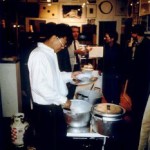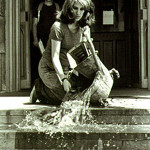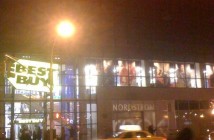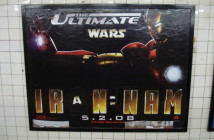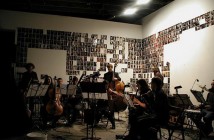Gift and Commodity Transactions in Contemporary Practice, a lecture hosted by Art in General
Art is not an ordinary commodity. Art is not a loaf of bread: it's easy to figure out how much it costs to grow wheat, bake it, and get it to the supermarket. Ultimately, with a piece of art the buyer is buying an idea and the artist's execution of that idea. The artist would hope a buyer agrees with the ideas and may have some personal relationships with the concepts. Lately there seems to be a trend that art may be becoming more of an investment strategy than a dogma. According to The Economist: "the sub-index of abstract contemporary art prices rose by 97%, a rate not seen since 1991." That sounds a lot better than my 4% savings account.
But before running out and purchasing barely dry canvas from recent grads, you'll have to ignore Marc Spiegler's article in New York Magazine entitled 'Why The Art Market Can't Crash And Why It Will Anyway', in which he warns that the art market is overpriced and we have yet to hit a correction in this out-of-control market. Curators are scouting out new talent all over the country in undergrad shows, snatching up pieces before the competition gets a jump on them. At the recent Armory show in NY, they capitalized on this gold rush with exclusive ticket prices: $1,000 to enter at five o'clock, $500 a half-hour later, and $250 for seven o'clock, thus assuring that the big spenders would have first crack at the new crop of talent.
Is this the best way to trade this objective commodity, through the appraisal of dealers and auction houses? Is there anything inherently wrong in selling these objects? Is anything really "priceless"?
Lewis Hyde sees art objects and ideas as a gift of talent, to be shared with the community, which would then be returned through other arts, such as writing, music, and other visual arts. It's a self-fulfilling cycle where future artists would be inspired by these works and return the gift. But Hyde goes even further: this isn't just pay it forward for the art world, the work of art is not art unless it is a gift.
"Works of art exist simultaneously in two 'economies', a market economy and a gift economy. Only one of these is essential, however: a work of art can survive without the market, but where there is no gift there is no art."
This was the topic for a panel discussion I attended organized by the Queens College MFA Student Committee. The talk, hosted by Art in General, included Adam Simon, Rirkrit Tiravanija, Mierle Laderman Ukeles, and Reinaldo Laddaga.
Rikrit Tiravanija, in an early piece "Pad Thai", cooked meals for an audience at the opening of that show, admitted he didn't think of his work as a gift in Hyde's sense of consciously giving back. As an artist he was first trying to find a way out and a way into the art world. In that first cooking piece, it was about bringing the everyday back into the gallery, things that were familiar to him, like preparing food. While in school it became a regular event to make a meal and have people over (some invited and some not) to take part in this exotic foreign food. His identity was closely tied to this providing act, in the daily structure of growing up in Thailand and making food at 6am with his grandmother for the passing monks on their way to prayer. At the same time he was interested in anthropology and how objects and ideas from a culture were displayed, often isolated behind glass. The work was trying to retrieve these ideas out of an institution and reanimate a culture and gallery space. Rikrit's gift to the audience was to redefine an act of art making, to bring a culture alive through a social experience and to experience a gallery in a completely new way, blurring the roles of artist, viewer and participant.
Since 1977, Mierle Laderman Ukeles has been artist in residence (unsalaried) at the New York City Department of Sanitation, a position that enables her to introduce radical public art as public culture into a system which serves and is owned by everyone. Since writing the "Manifesto for Maintenance Art, 1969," virtually all Ukeles's work has been public. She spoke about an upcoming piece, which will direct the responsibility of the gift onto the contributor. Her proposal for the recently closed Fresh Kills Landfill on Staten Island she will ask participants to choose an object with great personal importance to be embedded in a glass block. These blocks would then become part of a public earthwork, a truly public earthwork, easily visited by mass transportation, not something you'd have to travel out to the desert in Utah and rent a plane to view. Using bar codes and a web archive, viewers would be encouraged to search out these personal items in an area of New York created by billions of acts of rejection. This abandoned space would be transformed into something valuable by these hundreds of thousands of tiny gifts.
In April Adam Simon provided one solution for the out of control art market. As part of Art in General's new commissions projects he has launched fineartadoption.net, kind of an eBay for artworks, with the exception that artists determine the conditions of the "sale". This was in reaction the huge amount of work which otherwise would end up in storage, be destroyed or lost. In any urban area like New York where space is so highly valued, one can imagine the heartfelt parting with canvases and installations in dumpsters all across Williamsburg. It could be argued that the adopter leaves the artist with the gift of coming to terms with giving up the work, and knowing their conditions for care and display of the work will be followed. Under the usual system, once the art is purchased it is unconditionally the property of the purchaser. But for the audience he was also raising a number of troubling questions, what if the work was never adopted? Confronted with the failure of not even being able to give it away, would this drive artists to throw in the towel? Would this exchange system devalue work up for auction since I can just adopt that Matthew Barney video as long as I fall asleep to it every night? Probably not, but the gift here is piece of mind for the artist and a meaningful interaction with an individual who appreciates the creation so much they are willing to accept conditions to get it.
But can this gift-giving be translated into economic security? What financial gifts are supporting these artists? To what extent is an artist responsible for giving so much to a culture, which values so highly the first pictures of Tom Cruise's baby? Giving a gift of artistic creation may secure future artwork, a meal at a gallery, reinterpreted space or even peace of mind but as far as putting the kids through college... you're on your own.
----
[1] - Lewis Hyde, The Gift: Imagination and the Erotic Life of Property. New York: Vintage Books, 1979, p. 5
----
Audio excerpts from artists talks:
Rirkrit talks about how he approaches his work in terms of the gift, how much his identity has shaped the work and his latest project "The Land". (12:12)
Open this MP3 in a new window to listen.
Mierle describes an early piece, "Soho sidewalk Wash on Wooster Street", how the audience shaped the work and how this became the basis for future work. (10:09)
Open this MP3 in a new window to listen.
Special thanks to the Queens College MFA Student Committee for the organization of the panel, and Art in General for hosting the discussion.
Links:
Fine art adoption project
Art in General
All images courtesy of the artist and Art In General.


